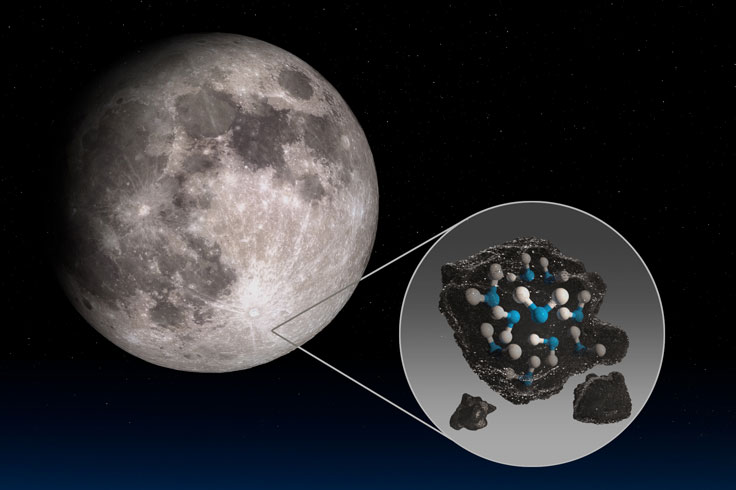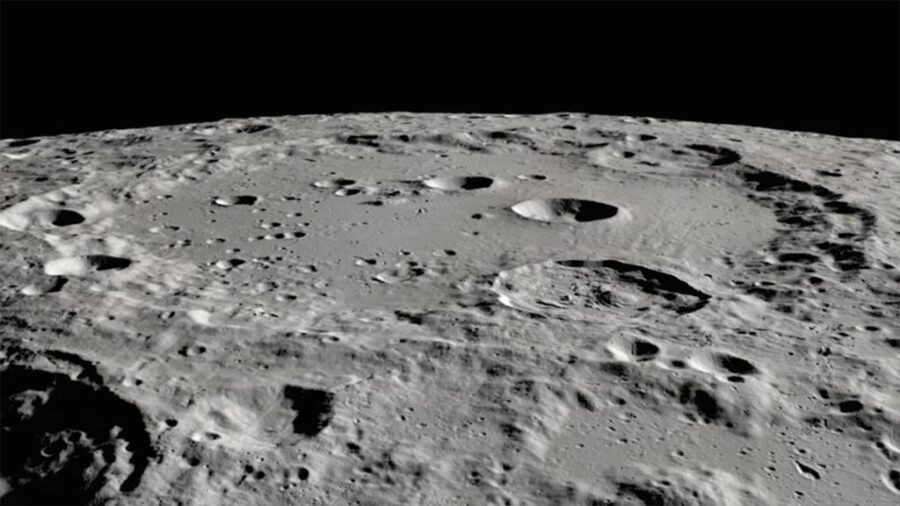Water exists even on the sunlit Moon, a new study shows — trapped in glass beads but still extractable for lunar exploration.

NASA / Daniel Rutter
Permanently dark craters are no longer the only places to find water on the Moon. NASA's Stratospheric Observatory for Infrared Astronomy (SOFIA) has found evidence of water molecules near in the Moon's sunlit Southern Highlands.
A separate analysis of lunar topography found that areas as small as a centimeter across — but adding up to 8,000 square kilometers (3,000 square miles) — could act as cold traps where water ice collects.
Both discoveries appearing today in Nature Astronomy give new insight into water distribution on the lunar surface. But they also require follow-up study to assess their implications for future exploration of the Moon.
Water Molecules on the Moon
Spacecraft observations have revealed the presence of water ice in permanently shadowed craters at the lunar poles, where temperatures stand below the 110 K (-262°F) vacuum sublimation point of water ice.
Other studies have also found that the spectral fingerprints of hydrogen at near-infrared wavelengths of 2.8 to 3 microns are widespread on the sunlit part of the Moon. However, while those features can come from water, they can also come from hydrogen-oxygen bonds in minerals containing hydroxyl (OH) groups. So they are not proof of water molecules. Sunlit regions are exposed to harsh ultraviolet radiation that breaks up water molecules but does not split hydroxyl groups.
Seeking to resolve that ambiguity, Casey Honniball (now at NASA Goddard Space Flight Center) and colleagues searched for spectral features present only in molecular water and identified an emission band at 6 microns. Finding an instrument to make the observations was much harder, as our atmosphere is completely opaque at that wavelength. No spacecraft could perform spectroscopic imaging of the Moon at that wavelength either.
Honniball’s only option was FORCAST, the faint-object infrared camera on SOFIA, the 2.5-meter telescope that flies aboard a modified 747 above 99% of the atmosphere's water vapor. SOFIA had never before observed the Moon.
She had only 20 minutes of observing time on a nine-hour flight in 2018, but she was able to observe two regions: one near 60°S (including Clavius Crater), where high hydrogen levels had previously been measured, and one at lower northern latitudes in Mare Serenitatis, the Sea of Serenity, where hydrogen levels were low. In Nature Astronomy, her group reports that the higher-latitude, high-hydrogen site has water molecule at concentrations 100 to 400 parts per million higher than what was found in the more equatorial site.

NASA / Moon Trek / USGS / LRO
How did water molecules withstand destruction by the harsh ultraviolet light? Honniball’s team compared spectra of the Clavius site with those of meteorites that had interacted with water and of basalts from mid-ocean ridges on Earth. The researchers suggest that perhaps water is trapped in impact glasses formed after micrometeorites smash onto the lunar surface. The impact energy vaporizes both the impactor and some of the rock it’s impacting; that vapor cools quickly to form glass. She thinks already-present hydroxyl groups combine to form water molecules that are then trapped in the glass, which protects them from incident ultraviolet light.
“They clearly detect molecular H2O on the sunlit lunar surface for the first time,” says planetary scientist Paul Hayne (University of Colorado, Boulder). (Hayne was not involved in the SOFIA observations but published a separate analysis of cold traps in the same issue of Nature Astronomy). The presence of water molecules is important because they can be extracted from mineral grains much more readily than hydroxyl groups can.
These results also are good news for SOFIA, which NASA proposed cancelling in February because of its high operating costs. At $82 million a year, SOFIA's costs are second only to the Hubble Space Telescope. Congress later restored SOFIA to the budget.
Micro Cold Traps
In a separate study that appears in the same issue of Nature Astronomy, Hayne and colleagues reported the existence of large numbers of permanently shadowed cold traps as small as one centimeter on the lunar surface.
The researchers analyzed more than 5,000 images taken by NASA’s Lunar Reconnaissance Orbiter to identify the distribution of shadows where sunlight was striking the surface at steep angles. They then calculated how many of these regions would remain dark and cold enough to retain ice even if heated by adjacent sunlit areas.

NASA / GSFC / Arizona State University
“There are tens of billions of these micro cold traps from 1 cm to 1 m, which are widely distributed from 80° latitude to the poles,” Hayne told Sky & Telescope. Accounting for these smaller cold traps increases the total known area of cold traps about 20%, to about 40,000 square kilometers or 0.15% of the lunar surface.
Both studies raise further questions. So far, SOFIA has surveyed only two small areas for water. Honniball has two more hours of observations scheduled and has requested 72 additional hours to learn how water is distributed across the Moon’s sunlit surface.
Meanwhile, Hayne, who is principal investigator for the Lunar Compact Infrared Imaging System (L-CIRiS) due to fly on NASA's polar lander in 2022, will use the instrument’s panoramic images of the landing site to measure the size, abundance and temperatures of micro-cold traps. Further study should answer important questions about how water and other volatiles migrate within the inner solar system and across the lunar surface.
 3
3









Comments
Peter Wilson
October 27, 2020 at 11:57 am
Moon-dog was thirsty, so I gave her a bowl of water trapped in glass beads...
Seriously, any water molecules that have withstood billions of years of harsh ultraviolet light are going to be hard to extract.
You must be logged in to post a comment.
Yaron Sheffer
October 28, 2020 at 8:42 am
Hmmm, a new space-age definition for hard water? 😉
You must be logged in to post a comment.
Ken-Winters
October 28, 2020 at 6:09 pm
Humans won't be using ultraviolet light. There are other methods and it won't be difficult for us since we know many ways to get the water.
You must be logged in to post a comment.
You must be logged in to post a comment.